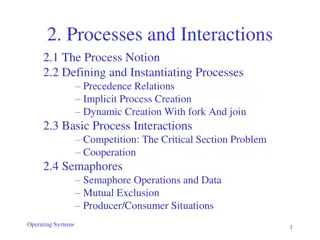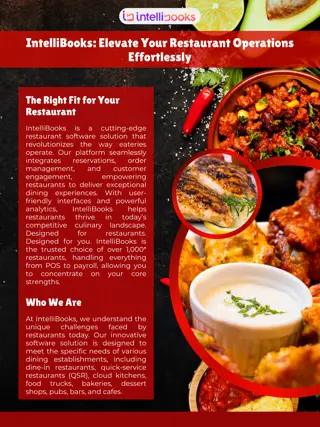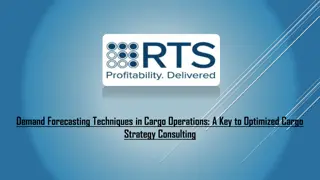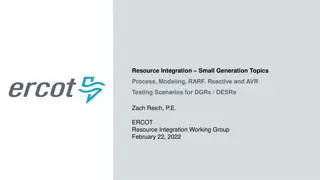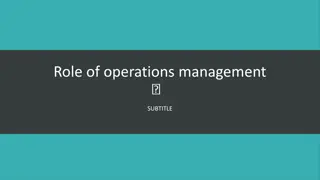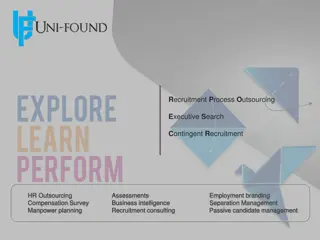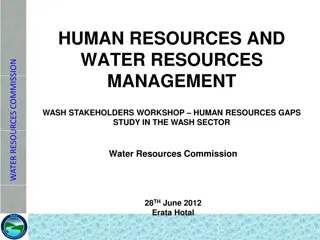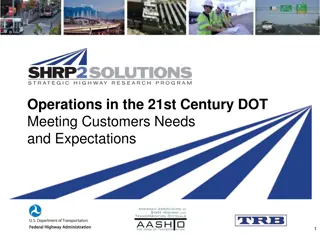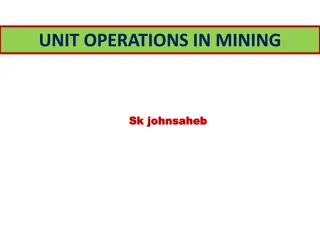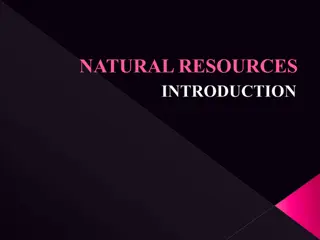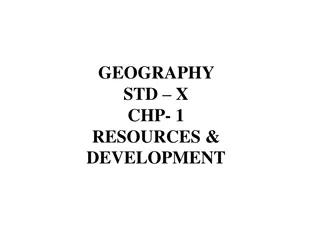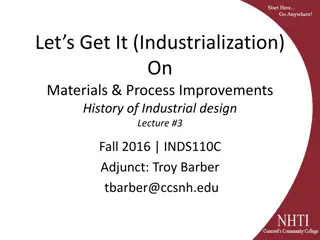Understanding Operations Processes and Transforming Resources
Operations processes involve transforming resources or inputs into outputs, such as products or services. These inputs can be materials, labor, or information, and the transformation can lead to significant changes in appearance, condition, or location of customers. Various businesses engage in transforming customers physically, psychologically, or through information, reflecting the evolving economy with a focus on tertiary sectors. Explore how Australian businesses adapt to the changing economic landscape by transforming information.
Download Presentation

Please find below an Image/Link to download the presentation.
The content on the website is provided AS IS for your information and personal use only. It may not be sold, licensed, or shared on other websites without obtaining consent from the author. Download presentation by click this link. If you encounter any issues during the download, it is possible that the publisher has removed the file from their server.
E N D
Presentation Transcript
IN THE OPERATIONS PROCESS RESOURCES OR INPUTS ARE EITHER TRANSFORMED, OR TRANSFORM SOMETHING ELSE, INTO OUTPUTS CALLED PRODUCTS OR SERVICES. Transformation means a thorough or dramatic change in form or appearance. Input means what is put into an operations process. Output means what comes out of an operations process.
INPUTS INPUTS In the operations process inputs of resources, such as skilled labour, machinery, raw materials and/or component parts transform customers (as in the haircut example); transform information (as in the newspaper example) or transform materials (as in the iPhone example).
TRANSFORMED RESOURCES (CUSTOMERS, TRANSFORMED RESOURCES (CUSTOMERS, INFORMATION, MATERIALS ) INFORMATION, MATERIALS ) Transforming a customer is possibly something you have not often considered. But when you get your hair styled your physical appearance is transformed. Indeed, were you to get cosmetic surgery your appearance might be dramatically changed! There are also businesses concerned with changing a customer s physiological condition. These businesses would include hospitals, dentists, surgeons, fitness instructors and gymnasiums.
Other businesses transform a customers psychological condition. For example, Kayne West, the rapper, owns a business that makes his customers feel differently. So, too, do theatres, cinemas, and indeed, theme parks such as Sea World, Movie World and Wet and Wild. These are not the only types of businesses concerned with transforming customers. Buses, trains, taxis and planes change the location of their customers. Other businesses, such as hotels, bed and breakfasts and motels accommodate customers. There is a very wide range of service businesses that transform customers.
Many Australian businesses transform information. This is because the Australian economy has changed over the last few decades. There is an increasing emphasis on the tertiary, quaternary and quinary sectors of the economy, and a decreasing emphasis on manufacturing. A large number of manufacturing businesses have relocated to low-wage countries such as Vietnam, Bangladesh and China. Businesses transforming information do so by storing the information, changing the location of the information or changing the properties of the information.
NOTE: Tertiary activities Tertiary activities include both production and exchange. The production involves the provision of services that are consumed. Exchange, involves trade, transport and communication facilities that are used to overcome distance. Tertiary jobs = White collar jobs. Quaternary activities Quaternary activities are specialized tertairy activities in the Knowledge Sector which demands a separate classification. There has been a very high growth in demand for and consumption of information based services from mutual fund managers to tax consultants, software developers and statisticians. Personnel working in office buildings, elementary schools and university classrooms, hospitals and doctors offices, theatres, accounting and brokerage firms all belong to this category of services. Like some of the tertiary functions, quaternary activities can also be outsourced. They are not tied to resources, affected by the environment, or necessarily localised by market. Quinary activities Quinary activities are services that focus on the creation, re-arrangement and interpretation of new and existing ideas; data interpretation and the use and evaluation of new technologies. Often referred to as gold collar professions, they represent another subdivision of the tertiary sector representing special and highly paid skills of senior business executives, government officials, research scientists, financial and legal consultants, etc. Their importance in the structure of advanced economies far outweighs their numbers.The highest level of decision makers or policy makers perform quinary activities. Quinary = Gold collar professions.
Google is typical of the data storage businesses. Millions of people access this information every day. Google earns revenue by providing advertisers access to the people accessing the information. Other businesses, such as Vodafone and Telstra, change the location of the information. When you chat to someone on the phone, you are changing the location of the information you are passing on to that person.
Businesses such as accounting firms transform information by changing the properties of the information. Accounting businesses, for example, change raw data into reports such as the Revenue Statement and Balance Sheet. Usually, when we think about the operations process, we think of a factory manufacturing products such as shoes, cans of drinks, clothing and electronics by transforming materials. The operations process that transforms materials does so by changing the physical properties of the material inputs. When a can of soft drink is manufactured, materials, such as an empty can, sugar, water and syrup are transformed in the operations process into a can of carbonated soft drink. Most manufacturing processes change the physical properties of the material inputs.
Sometimes the operations process changes the physical location of the materials. When you post a parcel to a friend in Melbourne, Australia Post moves the parcel from your address to your friend s. The Australia Post operations process is changing the location of the materials input. Retail businesses such as Coles and Woolworths change the possession of material inputs. The operations process in retail stores is concerned with changing the possession of material inputs such as, for example, a can of Edgell peas from the Edgell factory to your kitchen cupboard. It is important to realise that the operations process is usually concerned with transforming a mixture of material resources, information resources and customer resources.
TRANSFORMING RESOURCES (HUMAN RESOURCES, TRANSFORMING RESOURCES (HUMAN RESOURCES, FACILITIES) FACILITIES) Two of the inputs to the transformation process are different to the rest. This is because human resources and facilities do the transforming rather than being transformed. Human resources refer to the people in the business. Sometimes these people are called employees or staff, but the syllabus refers to them as human resources and we will generally use that terminology.
All human resources in the transformation process are important, even though their skills may be very different. The Kmart employee, for example, who fails to respond properly to a customer request, may cause the customer not to return to the business. This is why Kmart management takes human resource training so seriously. Imagine too, a factory assembly worker who loses concentration while assembling a part for, say, a mobile phone and does the assembly incorrectly. The phones these parts go into will not work. Customers will be upset and it will be expensive to replace the phones.
In other transformation processes the facilities are transforming resources. Facilities refer to things like the buildings and the machinery. The Coca-Cola factory at Northmead is an example of a business where the facilities are the transforming resources. The canning line is completely automated. Empty cans are automatically unloaded from trucks onto the canning line conveyor belt. The cans are washed, filled and sealed; each can is checked to ensure it is filled correctly, packed into boxes and stacked, by machines. Each machine is controlled by a programmable logic centre (PLC) which, in turn, is controlled by the central computer. The human resources are concerned with the maintenance of the facilities rather than with transforming inputs of raw materials and component parts into beverages.
TRANSFORMATION PROCESSES TRANSFORMATION PROCESSES The transformation process refers to the actual conversion of inputs to outputs. It is important that management makes this process as efficient and profitable as possible. Having spent time and money on ensuring the right inputs, the business needs to also make sure that the output is the desired result.
THE INFLUENCE OF VOLUME, VARIETY, VARIATION IN THE INFLUENCE OF VOLUME, VARIETY, VARIATION IN DEMAND AND VISIBILITY DEMAND AND VISIBILITY (i) Volume Volume refers to how much of a product is needed to be produced. The more a business can produce using the same production processes will often mean greater cost savings. For example a baker can make one loaf of bread in an oven, or 12 loaves; however, it is important to make sure that a demand does exist for the large amount produced or the savings in production costs will not result in any greater profits.
(ii) Variety The production process must also be flexible enough to provide variety, that is, although a basic product is provided, it can be adapted to suit individual customer needs. For example, a car manufacturer can use the same processes to make a basic model car with slight adaptations made for different colours.
(iii) Variations in demand It is important that volume flexibility is built into the production process so that the amount produced can be adjusted to meet variations in demand. If a business is to have short lead times (the time taken from the placing of an order to providing the customer with the product), then the operations department must be able to meet changes in demands. Inflexibility could lead to wasted resources and/or delays in meeting customer s orders. Increases in demand influenced Carman s Fine Foods operations. This business is based in Melbourne and started 20 years ago making muesli and selling to cafes in small quantities. After contracts with Coles and Woolworths where the muesli was promoted as an upmarket brand, Carman s had to drastically alter its production process and location to cope with huge demand.
(iv) Visibility Visibility refers to building a relationship with the customer; this not only builds customer loyalty but also enables the business to improve its operations. An example of this is asking customers to fill out satisfaction surveys and questionnaires. Sydney Morning Herald now requires paid subscriptions to access news via the internet and sought feedback about this about two months after the initiative was introduced. Questions were posed to investigate the times and types of access to digital information and results were used to tailor appropriate packages to both suit the needs of customers and boost the SMH s profits.
SEQUENCING AND SCHEDULING SEQUENCING AND SCHEDULING GANTT CHARTS, CRITICAL PATH ANALYSIS CRITICAL PATH ANALYSIS GANTT CHARTS, In order to transform inputs in such a way that they make are profitable for the business, the operations department must allocate resources efficiently, ensuring that the least amount of waste occurs. Production planning will look at such things as sequencing and scheduling so that goods and services are produced smoothly. Sequencing will consider in what order products should be made. This will enable management to determine the layout of the business, what inputs are needed and when.
Once the order of production is decided, management can then work on the scheduling of the production process. This will allow the right inputs to be in the right place on time, it will also allow for the required skilled employees to be available to do their specific task. If sequencing and scheduling is not planned, it will mean that resources may not be available as needed, or some inputs and employees are available when they are not needed getting in the way or causing confusion. This will be costly for the business and reduce profits.
In order to sequence and schedule the production process, management will use different planning tools. A Gantt chart is a type of bar chart that illustrates the start and finish dates of a project. The project will be broken down into the different tasks that must be performed and the time frame for their completion. This allows management to see what jobs need doing, when they need doing and any overlapping tasks. For example, Gantt charts were used for teams of people in the co-ordination and construction of building Royal North Shore Hospital.
Critical path analysis allows management to map out the production process, looking at the longest possible time frame the project could take. It is very like a flow chart that shows how one task will lead to another. This analysis not only helps sequence and schedule tasks but also to see where problems might arise.
TECHNOLOGY, TASK DESIGN AND PROCESS LAYOUT TECHNOLOGY, TASK DESIGN AND PROCESS LAYOUT Technology is used in the transformation process, whether it is a computer to type up documents or a fully computerised assembly line to make a can of soft drink. In the past, many production techniques were very labour oriented with an emphasis on repetitive tasks; however, with behavioural management theory, emphasising that employees are more productive when engaged in fulfilling work, and the development of new technologies, many products are designed and assembled using computer assisted technology (CAT). New technologies have allowed businesses to reallocate dangerous and repetitive tasks away from employees. This has allowed for more efficient production processes, and while new technology may be expensive in the short run, in the long run it usually results in more cost effective practices and, therefore, higher profits.
Task design refers to planning the flow of activities that has to be done to complete a task. If the flow of activities are organised into a logical sequence, employees will be able to successfully perform and complete their allocated task. Task design usually involves the following steps: - Define what needs to be done Identify who needs to do it Break down the task into specific skills and duties Allocate time elements and difficulty levels to the task
The process layout will affect how efficiently a business is able to transform the inputs into an output. Technology and task design will impact on this layout. Technology will need to be located in the business dependent on its requirements as access to electricity, cooling, water, etc. If the technology is needed to be used by different employees at different times, task design will identify this so that clashes do not occur. At all times the process layout needs to emphasise a smooth flow of production and occupational health and safety.
MONITORING, CONTROL AND IMPROVEMENT MONITORING, CONTROL AND IMPROVEMENT In order to ensure that it is meeting its goals, a business must have strategies that involve monitoring, controlling and improving production processes. Monitoring refers to the collecting and analysing of information so that processes can be improved. Businesses will put into place Key Performance Indicators (KPIs) so that they can actually see if targets are being met. For example a manufacturing business may have a target of making a certain amount of items in a day; a retail business may have expectations of selling a certain number of products. Monitoring these indicators will allow the business to see if these targets are being met. If they are not being met, then the reasons can be analysed so that corrective action can be taken.
Control is the process of comparing the predetermined target against the actual result and assessing what action is needed to correct a shortfall. Monitoring and control lets the business undertake continuous improvement. This will see the reduction of wastage and inefficient work practices. Monitoring operations will help the business do such things as reduce the time that it takes to provide the customer with the good or service; to reduce the costs involved in providing the product; to reduce dangerous work place practices and to provide a better quality product.
OUTPUTS OUTPUTS Outputs are the end result of a business s production processes, the good or service that is sold to the customer. Some outputs are also inputs into another business s production process. For example a flour mill will make wheat, sell this wheat to a baker who will in turn make a cake which is sold to a caf or an individual customer. It is vital that the output of a business must meet the demands of customers if the business is to be able to cover the costs of making the product. The cake made by the baker must sell for more than the cost of making it.
CUSTOMER SERVICE CUSTOMER SERVICE Customer service is a non- physical output of the operations process. It refers to how well the business can meet the expectations of customers. Although this is often seen as the domain of the marketing department (and will be discussed more in this topic), it is important that the operations department recognises its obligations in this area. Operations management is responsible for the provision and quality of the product and if customers are disappointed in these things, they will look to other businesses for an alternative product. A good quality product, which is provided in a timely fashion, will not only encourage customer loyalty but will often let the business charge a higher price than competitors.
WARRANTIES WARRANTIES By law in Australia, all products sold must come with a warrantee or guarantee that the product will serve its advertised purpose. Many businesses when selling a physical product over a certain value will offer a written warranty, valid for a period of time. In monitoring the effectiveness of the operations department, management can look at how many warranty claims are made. Customers usually only make a warranty claim when the product is defective in some way. If the number of claims is high, it would indicate that something is wrong with the production process and this must be rectified. If the business has good monitoring and quality control mechanisms in place, then the business will be able to reduce warranty claims.
REVIEW QUESTIONS 1. Provide a definition for (i) inputs (ii) transformed resources (iii) transforming resources 2. Outline the role of materials, information and customers in the production of a loaf of bread. 3. Assess the importance of job design and job specification in the production process. 4. Discuss the factors that management must consider when developing production facilities. 5. Distinguish between volume, variety and visibility. 6. Outline the implications for a business if it cannot meet variations in demand. 7. Discuss the importance of scheduling and sequencing in the production process. 8. Describe the role of technology in modern production processes. 9. Explain the importance of good task design and process layout in business. 10.Examine how a business can use Key Performance Indicators (KPIs) to monitor its processes. 11.Predict what may happen to a business that does not focus on customer service. What form should good customer service take? 12.Outline the importance Cathay Pacific puts on customer service. 13.Argue the following statement, Monitoring, control and improvement is the most important part of operations.





